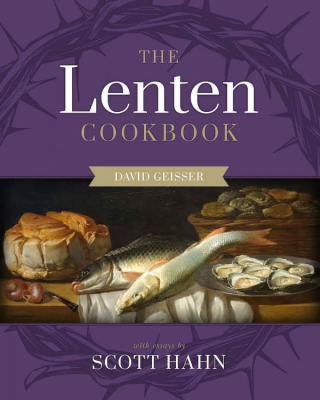Book: The Lenten Cookbook

Here is a book of two halves: a series of essays by Scott Hahn on the practice of fasting, especially during Lent, followed by a collection of chef David Geisser's recipes, mostly meat-free but none the worse for that.
Hahn's essays provide a clear justification for fasting and abstinence: 'Fasting, and prayerful self-restraint in food choices generally, doesn't have to be either monastic or a few-times-a-year imposition, but part of the everyday arsenal for spiritual growth (and warfare) available to every Christian.' Setting limits on what we eat and drink can help us discern our real bodily needs and improve our physical health, but Hahn sees it primarily as sacrificial: giving up the comfort of abundant good food. Such comfort can delude us into self-sufficiency, leaving little room for our Creator. It needs to be challenged.
Modern life does not lend itself so readily to communal fasting as did mediaeval Christian society, with its shared rhythm of fasts and feasts. I regret that Hahn did not acknowledge how we might learn from our Muslim brothers and sisters who observe Ramadan, even when it falls in midwinter or high summer. A young neighbour told me she was going to 'do the whole thing' though she was too young to be obliged to do so. She succeeded!
The Western Church has eased its fasting laws since the time of Pius XII, partly in response to present day pressures, partly to address the legalism that had crept in and the dispensations that were often claimed. 2022 may be the time to revisit fasting but we must beware of causing more harm than good, a danger especially of self-designed and self-imposed regimes: one's own health may suffer and dear ones feel the edge of the penitent's grumpiness!
Hahn cites a prayer from the Byzantine rite of Vespers which sums up Lenten fasting:
While fasting with the body, brothers and sisters,
let us also fast in spirit.
Let us loosen every bond of iniquity;
let us undo the knots of every contact made by violence;
let us tear up all unjust agreements;
let us give bread to the hungry
and welcome to our house the poor who have no roof to cover them,
that we may receive mercy from Christ our God.
Hahn commends Lenten "frugality for almsgiving, repentance, preparation [for Easter] and imitation of Christ" but could have developed further his reflection that frugality should be our attitude when choosing food, even a snack or a drink. Eating less meat is in itself an act of repentance, of turning away from using too many scarce gifts of Creation.
And so to David Geisser's recipes. He begins with a list of dishes fulfilling traditional fasting norms, some free from meat, dairy and alcohol, others with recommended substitutes for them; some of the alternatives are fuss-free and inexpensive, but is it frugal to replace butter with puréed avocado when the fruit is flown from abroad? Is out of season asparagus in any way penitential?
There are dishes we can enjoy with a clear conscience. The baked muesli could be cooking while the oven is on for one of the excellent breads. The ingredients for the potato bread in my review copy do not include potatoes, which is disappointing, I would certainly have tried this! The flatbreads and spice bread would reconcile any carnivore to a bread and soup lunch. Hot cross buns in England, at least, start to appear in the supermarkets around 1 January, and are still on sale well after Easter. They originated as a Good Friday celebratory collation; a spiced, fruited bun with a cross on the top, more recently made of flour paste or marzipan and glazed on turning out of the oven. Geisser's Swiss versions are quite different and include one with Rosemary. Rosemary is for remembrance, appropriate for Good Friday, but this particular bun could be served at any time of year.
Carrot soup with orange is a fine variation; I would reserve a tablespoonful of carrot batons to garnish each bowl. Pink peppercorns are a condiment that would forever hide away at the back of our kitchen cupboard. Coarsely ground black pepper will do. The other soups are worth trying, especially the cream of corn, while the cold tomato soup is one for summertime.
Tomatoes evoke salads and there are tasty salads here but exotic ingredients would have to be replaced. The bread salad with plenty of tomatoes will be tried in this household.
From the collations, or light meals, I will surely be trying the potato pancakes, perhaps using cornmeal instead of semolina; also the bread pudding Carthusian style. The baked vegetables recipe is very like one of my wife's tasty standards, so it is recommended. More of her specialities are mirrored among the main meals: Lentil and Eggplant Moussaka and Eggplant au Gratin. My own favourites include leek quiche - though I have not used saffron - and spinach quiche, which gladly accepts bacon strips out of the Lenten season. Best of the curries I feel would be the butternut squash variety.
I am glad to have seen this book. It is informative and well presented, with colour reproductions of old master paintings and the prepared dishes. Quantities are given in metric units as well as US cups and spoonfuls, so no need to flick back to a conversion chart. I hope readers find inspiration to fast from Hahn's essays and to cook frugally but joyfully from Geisser's recipes.
Manchester, New Hampshire, Sophia Institute, 2022
ISBN: 978-1-64413-469-6















